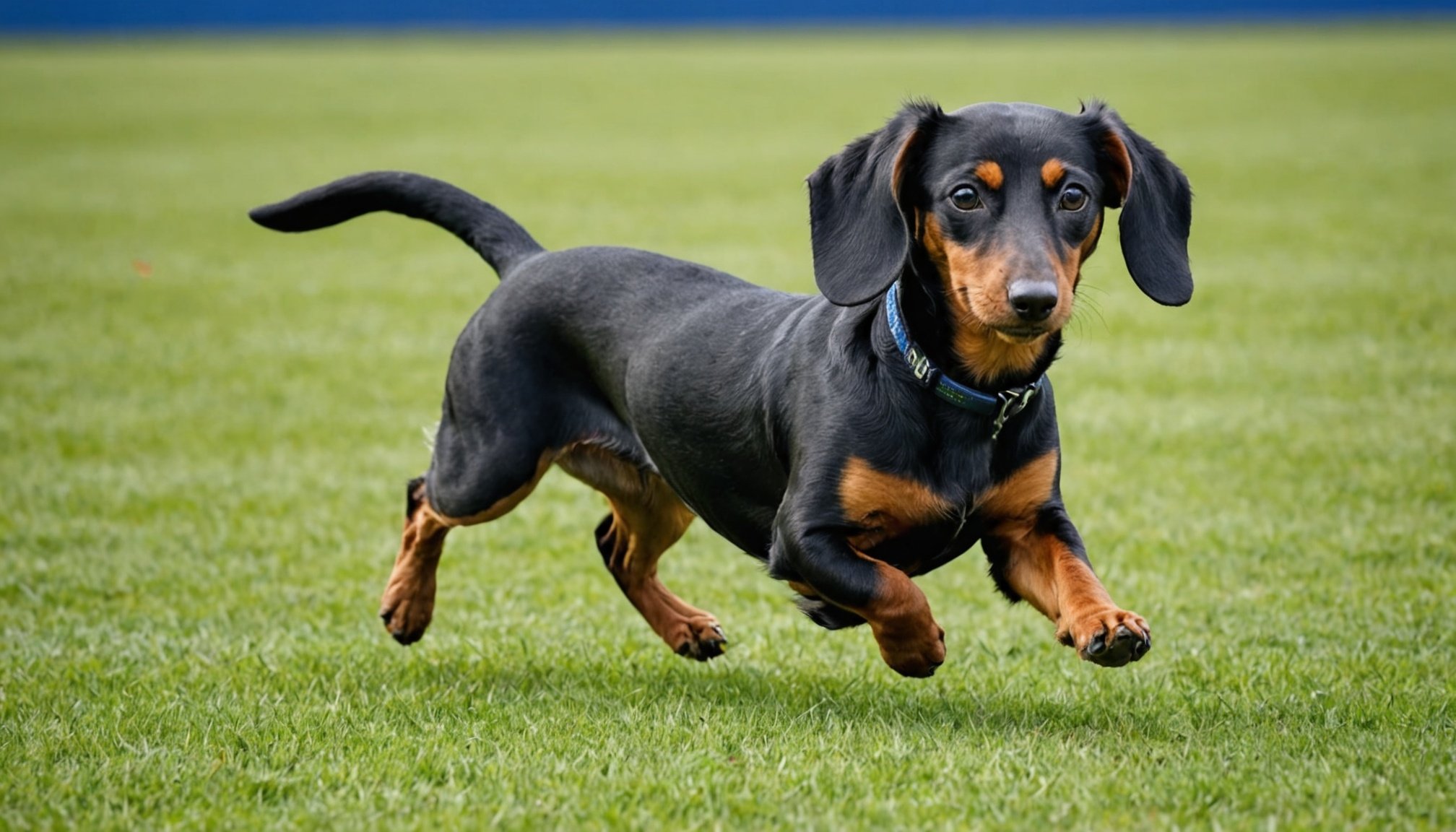Understanding Dachshund Anatomy and Back Health
Dachshunds, often recognized for their long bodies and short legs, possess a unique anatomical structure that makes them prone to specific health concerns. Their elongated spine is supported by a relatively small rib cage and short limbs, which can predispose them to back issues. This anatomical design, while endearing, requires careful attention, especially when considering their participation in dog sports.
One of the most common spinal conditions affecting dachshunds is Intervertebral Disc Disease (IVDD). This condition involves the deterioration of the discs between the vertebrae, leading to pain and potential paralysis. Dachshunds are genetically predisposed to IVDD, making back health a critical aspect of their overall well-being.
Also to read : Essential Tips for Primping Your Long-Haired Chihuahua: Expert Grooming Practices Unveiled!
Understanding the intricacies of dachshund anatomy is essential for ensuring their health, particularly if they engage in activities that stress their spine. While proactive measures can help maintain their back health, owners should remain vigilant and consult with a veterinarian for appropriate exercises and activities. By doing so, dachshunds can safely enjoy the benefits of physical activity without compromising their back health. Engaging them in low-impact sports tailored to their anatomy can provide both physical and mental stimulation.
Suitable Dog Sports for Dachshunds
Finding the right dog sports for dachshunds involves balancing their energetic nature with their physical limitations. With their long bodies and short legs, these spirited companions require activities that are both engaging and safe.
In the same genre : Identifying and Managing Common Skin Issues in Your Pet Rabbit: A Comprehensive Guide
One ideal sport is agility, which can be adapted to suit a dachshund’s unique body. By using lower jumps and widening tunnels, agility becomes a fantastic way for dachshunds to build confidence while having fun. Likewise, obedience training serves as an excellent choice, focusing on mental stimulation rather than physical exertion. This helps maintain dachshund activities within a safe range, while reinforcing obedience and discipline.
When considering a sport, prioritize the dog’s safety. It’s crucial to avoid activities involving high jumps or extensive running, as these can be harmful to a dachshund’s spine. Instead, opt for low-impact exercises that keep their injury risk minimal. Additionally, monitor their behavior and enthusiasm; a dachshund’s enjoyment and eagerness to participate are key indicators of suitable sports.
By understanding your dog’s limitations and preferences, you can provide them with enriching experiences that keep them active and healthy. Choose sports that celebrate their unique traits and ensure their well-being.
Expert Insights on Minimizing Injury Risks
Engaging in dog sports can be thrilling for dachshunds, but injury prevention should be a top priority. To minimize risks, veterinarians and canine sports specialists provide crucial expert advice that includes fitness assessments as a key component. Understanding a dachshund’s fitness level before they dive into activities helps gauge how their body might cope with the physical demands.
Prior fitness assessments, as recommended by specialists, are like preventive checkups enabling adjustments to their exercise regime. If a dachshund’s fitness falls short, an expert may suggest specific exercises to build strength and endurance before participating in dog sports.
Dog sports safety extends beyond preparation; it involves precise actions during the activity. Safety measures include maintaining a keen eye on dachshund’s positioning, especially ensuring their long backs remain supported. Damage to their spinal area can result from strenuous movements or incorrect landing techniques in agility sports. Using appropriate equipment and tailoring the environment, like cushioned surfaces, minimizes stress on their bodies.
In summary, expert advice revolves around laying a strong fitness foundation and practicing vigilant safety measures. By doing so, you can ensure that your dachshund enjoys sporting activities with reduced risk of injuries.
Training Tips for Healthy Engagement in Sports
Engaging a dachshund in sports requires careful preparation to ensure both enjoyment and safety. Dog training should involve specific sports preparation strategies to optimize performance without risking injury.
Begin with strength training exercises designed to support their robust muscles while accommodating their unique physique. Activities like gentle tug-of-war or low-impact agility courses can be beneficial. Flexibility exercises, such as controlled stair climbing or slow weaving, enhance their agility and prevent strain during activities.
It’s vital to emphasize the importance of gradual training progression. This approach minimizes stress on your dog’s body and helps build stamina safely. For instance, begin with shorter play sessions and incrementally increase the duration as your dachshund becomes more comfortable and resilient.
Moreover, incorporating a variety of exercises is crucial. Diversity in training, including basic obedience commands interspersed with active play, keeps them interested and reinforces good behaviour. While engaging in these activities, monitoring your dog’s response is essential, allowing you to adjust the intensity according to their comfort and fitness levels, ensuring healthy engagement in sports.
Personal Anecdotes and Case Studies
Experiencing the world of dog sports with dachshunds reveals both challenges and rewards. Many owners share fascinating reflections on their dachshund’s journeys in various sports. For example, one owner recounts their experience in agility competitions, highlighting how their dachshund’s enthusiasm transformed their initial skepticism into a success story. Agility training not only improved their dog’s physical fitness but also their bond, as teamwork was essential.
Managing back health in sporting dachshunds is a frequent concern among owners. A specific case study describes how incorporating swims and controlled jumps, under veterinary guidance, helped in strengthening their dachshund’s core and minimizing the risk of spinal issues. This anecdote confirms the importance of tailored exercise regimens and attentive monitoring to maintain health while enjoying sports.
Many owners also report unexpected benefits, such as increased confidence in their dogs and social connections formed with fellow dachshund enthusiasts. These shared experiences through various case studies depict the potential for significant growth and enjoyment when dachshunds are appropriately engaged in sports. Lessons learned often emphasize patience, adaptability, and commitment, providing encouragement to prospective dachshund sport enthusiasts.
Ongoing Care and Monitoring
Active dachshunds require vigilant dog health monitoring to ensure their well-being in sports and active play. Regular veterinary check-ups are crucial. They help to catch potential health issues early, enabling better management and prevention of injuries.
Recognizing signs of distress or back pain is key to maintaining your dog’s health. Pay special attention during sports activities, as this is when injuries can occur. Indicators of back pain include a reluctance to move, changes in posture, and signs of anxiety. Quick identification can lead to prompt intervention.
An effective wellness plan is essential for dachshunds involved in sporting activities. Tailor this plan to include balanced nutrition, appropriate exercise routines, and rest periods. It’s also wise to incorporate therapies like massages or chiropractic care when necessary.
Injury awareness involves being proactive. Knowing your dog’s limits and avoiding high-risk activities can reduce the chances of injury. Keeping a close watch on your dog’s behavior and consulting with veterinarians can refine your approach, ensuring your dachshund remains healthy and active. This dedicated approach helps create a supportive environment where your pet can thrive.











